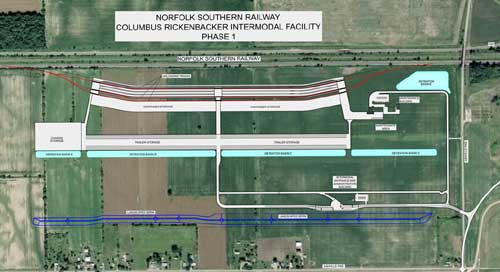
SEPTEMBER 2005
Passing the Torch (cover)
Niche Airport Boosts Middle East Logistics
O'Hare Expansion Clears Another Hurdle
Global Trade Spurs
Bevy of Port Projects
Other Ports Reach Another Level
Road and Rail,
Both on Rise, Seek Ways to Converge
Rail Activity
Not So Skinny
Intermodal Central to Movement's Future
Volume Separators; Want Big Numbers? Think Small
Request Information

INFRASTRUCTURE REPORT 2005
Road and Rail, Both on Rise,
Seek Ways to Converge
Seek Ways to Converge
To discover the importance of highway projects to business, one need only look at the primacy of logistics in the facility activity of nearly every industry sector. Then look at the per mile costs of operating commercial trucks, as analysts Gary Barnes and Peter Langworth of the Humphrey Institute of Public Affairs did in 2004.
A baseline cost of 43.4 cents per mile ratchets up to nearly 49 cents with poor pavement conditions and nearly 53 cents in city driving conditions. Those calculations were done based on a fuel price of $1.50 per gallon, so feel free to add 8 cents to those per-mile figures in 2005.

|
| The $100-million Norfolk Southern intermodal terminal at Rickenbacker International Airport in Columbus, Ohio, comes at a crucial time for the railroad's freight volume and the former military facility's industrial growth curve. |
As the bottlenecked transportation bill finally broke free from its own jam in the U.S. Congress earlier this year, some 4,000 pet projects stood to receive a portion of the measure's $286.4 billion in funds.
According to Taxpayers for Common Sense, there are 6,361 highway, bus and rail projects in the bill worth around $23 billion. Among them were feasibility studies for new Interstate highways, including I-3 from Savannah, Ga., to Knoxville, Tenn., and I-14 from Natchez, Miss., to Augusta, Ga. In all, more than $189 billion is slated for highway projects through fiscal year 2009, and more than $45 billion is going to public transportation.
Regions and projects expecting big things from the bill's funds include San Diego's border area, outer Boston transit and the Hoover Dam bypass, which will receive its next injection of $50 million. Missouri will see $50 million for a bridge over the Missouri River in Kansas City, and $75 million for a new bridge over the Mississippi River in St. Louis.
Big highway projects don't come much bigger (or at a better time) than the Asian Highway Network, an intergovernmental agreement among 26 Asian nations that provides for projects and upgradings along some 87,561 miles (141,000 km.) of roads linking the nations and linking to Europe. The entire network will enable a drive from Tokyo to Istanbul and is expected to be complete by 2010. That's saying something for a project that was originally initiated by United Nations Economic and Social Commission for Asia and the Pacific (ESCAP) in 1959 and revised in 2003. A look at the road ahead for these roads reveals the reason for the long time frame:
"Sixteen per cent of the roads are below the minimum standards and an estimated $18 billion is needed to upgrade and improve the highway," said Kim Hak-Su, executive secretary of ESCAP, on the occasion of the agreement coming into force on July 4, 2005. ESCAP is now working with the Asian Development Bank, the World Bank, the Japan Bank for International Cooperation, the Islamic Development Bank and other partners to help countries identify sources for investment.